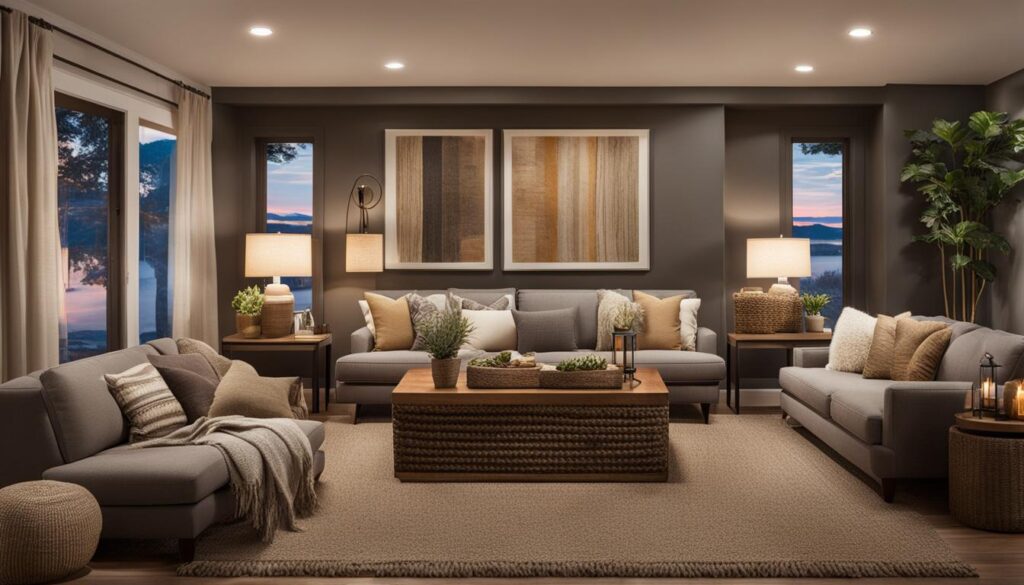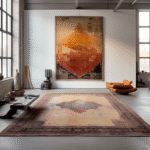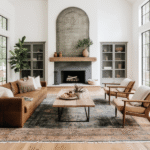Living room lighting is an essential aspect of interior design, and recessed lighting has become a popular choice for many homeowners. When it comes to placing recessed lighting in the living room, there are several important factors to consider. The main purpose of the space, other lighting fixtures, and the need for customization options all play a role in achieving the desired lighting effects.
Designers Catherine Staples, Beth Dotolo, and Rosanna Bassford offer their expert insights on the matter. Staples advises against over-lighting the space and suggests using dimmer switches for better control. Dotolo recommends combining recessed lighting with decorative pendants or chandeliers to add style and variation. Bassford highlights the importance of avoiding placing recessed lights directly above seating areas to prevent uncomfortable shadows.
When determining the placement of recessed lighting, it is generally recommended to divide the ceiling’s height in half to determine the spacing between each light. Additionally, considering the natural lighting and intended use of the space is crucial in determining the amount of lighting needed. With a wide selection of sizes, shapes, trim options, and bulb types available, recessed lighting offers endless possibilities to enhance the style and functionality of any living room.
Table of Contents
Key Takeaways:
- Consider the main purpose of the living room and other lighting fixtures when placing recessed lighting.
- Avoid over-lighting the space and use dimmer switches for better control.
- Combine recessed lighting with decorative pendants or chandeliers for added style and variation.
- Avoid placing recessed lights directly above seating areas to prevent uncomfortable shadows.
- Divide the ceiling’s height in half to determine the spacing between each recessed light.
Understanding the Pros and Cons of Recessed Lighting in Different Rooms
When it comes to lighting your home, selecting the right fixtures and styles for each room is essential. One popular option for modern living room lighting is recessed lighting. However, it’s important to understand the pros and cons of using recessed lights in different areas of your home to ensure the perfect balance of functionality and style.
The Living Room
The living room is a space where comfort and ambiance are key. While recessed lighting can provide a sleek and modern look, it may not be the best choice for creating a cozy atmosphere. In this room, it’s recommended to rely on other overhead fixtures, sconces, and table lamps to achieve a more ambient and inviting feel.
The Kitchen
In the kitchen, recessed lighting is often favored for its practicality. It provides ample task lighting for cooking, cleaning, and food preparation. With recessed lights strategically placed above countertops and workspaces, you can ensure that every corner of your kitchen is well-lit and functional.
The Bedroom
The choice of lighting for the bedroom depends on the style and mood you want to create. In vintage homes, it’s often best to avoid recessed lighting and instead opt for semi-flush or chandelier fixtures. This preserves the classic aesthetic and adds a touch of elegance. In contemporary homes, recessed lights can seamlessly blend into the design and provide a clean, minimalist look.
Each room in your home has unique lighting needs, and while recessed lighting may be suitable in some areas, it may not be the best choice in others. Consider the specific needs of each room, the desired ambiance, and the overall style of your home when deciding on the lighting options that will best suit your space.
| Pros | Cons | |
|---|---|---|
| Living Room | – Sleek and modern look – Provides even lighting | – May not create a cozy ambiance |
| Kitchen | – Practical and functional – Provides ample task lighting | – May lack warmth and coziness |
| Bedroom | – Blends seamlessly with contemporary design – Provides a clean and minimalist look | – May not match the style of vintage homes |
Tips for Placing and Choosing the Right Recessed Lighting
When it comes to achieving the perfect lighting in your living room, LED can lights offer a versatile and energy-efficient solution. Here are some tips for placing and selecting the right recessed lighting for your living room.
Proper Placement:
One key factor to consider is the placement of your recessed lights. It is advisable to install them around the perimeter of the room, avoiding direct placement above seating areas. Focus on illuminating doorways, walls for artwork, and pathways to ensure even lighting throughout the space.
Choosing the Right Size and Trim:
The size of the recessed lighting fixture should be chosen based on your ceiling height and the desired lighting coverage. Consider different trim options, such as baffle, reflector, gimbal, and shower trims, as they offer different lighting effects and functionalities. Evaluate your needs and preferences to determine the most suitable trim for your living room.
LED Can Lights:
LED recessed lighting is highly recommended for its energy efficiency and long lifespan. It provides bright and crisp illumination while reducing energy consumption. Additionally, LED lights offer tunable and selectable lighting options, allowing you to customize the color and temperature of your living room lighting to create the desired ambiance.
When exploring living room lighting ideas, don’t overlook the benefits of LED can lights. By carefully placing and selecting the right recessed lighting, you can enhance the overall aesthetic appeal and functionality of your living space.
FAQ
What factors should I consider when placing recessed lighting in my living room?
It’s crucial to consider factors like other lighting fixtures, the main purpose of the space, and the need for customization options when placing recessed lighting in the living room.
How can I avoid over-lighting my living room with recessed lighting?
It is recommended not to over-light the space and to use dimmer switches for control.
Can I pair recessed lighting with other decorative lighting fixtures in the living room?
Yes, you can pair recessed lighting with decorative pendants or chandeliers for added style and variation.
Where should I avoid placing recessed lights in the living room?
It’s important to avoid placing recessed lights directly above seating areas to prevent uncomfortable shadows.
How should I determine the spacing between each recessed light?
Divide the ceiling’s height in half to determine the spacing between each recessed light.
How should I determine the amount of recessed lighting needed in my living room?
Consider natural lighting and the intended use of the space, such as workspaces versus relaxation areas, to determine the amount of recessed lighting needed.
What options do I have in terms of sizes, shapes, trims, and bulb types for recessed lighting?
The selection of recessed lighting includes various sizes, shapes, trim options, and bulb types, providing endless possibilities for any style and size of home.
Is recessed lighting suitable for kitchens?
Yes, recessed lighting is often favored in kitchens for its practicality, providing ample task lighting for cooking and cleaning.
Is recessed lighting recommended for bedrooms?
The choice between recessed lights and other lighting options in bedrooms depends on the style of the house. Vintage homes may benefit from other fixtures, while contemporary houses can incorporate recessed lights seamlessly.
How can I achieve the desired lighting effects with recessed lighting in different rooms?
Proper placement of recessed lighting plays a crucial role in achieving the desired lighting effects. It is recommended to install recessed lighting around the perimeter of a room and avoid placing them directly above seating areas.
What should I consider when choosing the right recessed lighting?
When choosing the right recessed lighting, consider factors such as the size of the fixture, type of trim, and color temperature. The size of the fixture should be chosen based on ceiling height and desired coverage. Different trim options offer various lighting effects and functionalities. LED recessed lighting is a popular choice for its energy efficiency and long lifespan.
Can I adjust the color and temperature of recessed lighting?
Yes, with the use of tunable lighting and selectable lighting options, you can customize and adjust the color and temperature of recessed lighting.


